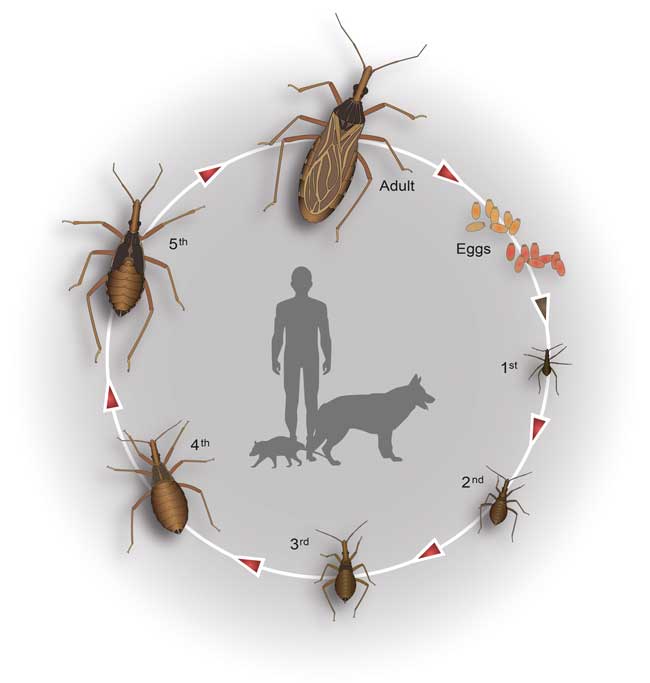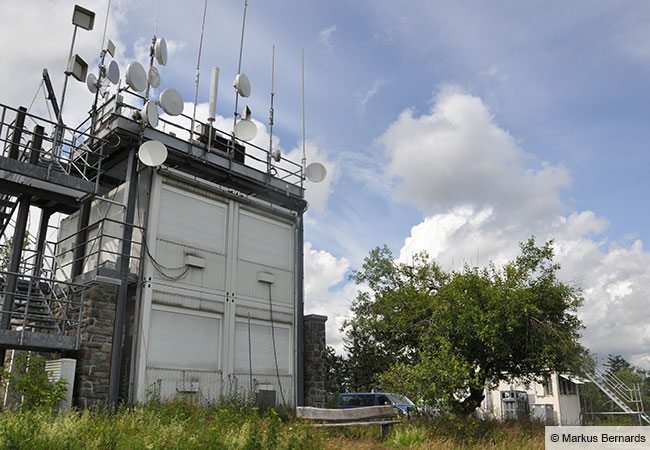In Central and South America, predatory blood-sucking bugs transmit the causative agent of the widely prevalent Chagas disease. As the disease can induce severe symptoms and to date there is no vaccine against the Trypanosoma parasites, the main approach at present is to control the bug using insecticides. A German-Brazilian research team has now studied how trypanosomes change the bug’s intestinal microbiota. The long-term goal: to change the bacterial community in the predatory bug’s intestine in such a way that it can defend itself against the trypanosomes.

The predatory bug Rhodnius prolixus is one of the main vectors of Chagas disease in the north of South America and in Central America. Photo: Dr Erwin Huebner, University of Manitoba, Winnipeg, Canada/ Wikimedia Commons
According to estimates by the World Health Organization (WHO), between six and seven million people worldwide, predominantly in Central and South America, are infected with the Trypanosoma cruzi species of trypanosome. This single-celled (protozoan) parasite causes Chagas disease (American trypanosomiasis), which in the acute phase is inconspicuous: only in every third case does the infected person develop any symptoms at all, which can then be unspecific, such as fever, hives and swollen lymph nodes. However, the parasites remain in the body, and many years later chronic Chagas disease can become life-threatening, with pathological enlargement of the heart and progressive paralysis of the gastrointestinal tract.
There is no vaccine against the pathogen and treating the disease in the advanced stage is difficult. That is why the focus in Latin America is rather on controlling the bug that transmits Chagas trypanosomes: the predatory blood-sucking bug of the insect subfamily Triatominae. It ingests the trypanosomes during the sting, which then colonize its intestine. Through its faeces that it mostly deposited next to the bite, the bug excretes the pathogen, which is often rubbed into the wound when scratching the extremely itchy bite.
Although the number of new infections has dropped in various regions where insecticides are sprayed on a wide scale, problems are emerging: over the last decade, resistance to common insecticides by several species of predatory bugs has been increasingly observed. These insecticides also have a negative impact on the environment and the local population.

Example of the hemimetabolic life cycle of the predatory triatomine bug Rhodnius prolixus. Shown are the adult vector, freshly laid, milky-white eggs, mature, reddish eggs and five nymphs. Red arrows mark a blood meal for the moulting process and egg production. Pictured in the middle are frequent hosts, such as dogs, opossums and humans. Graphics: Fanny E. Eberhard
Researchers worldwide are making intense efforts to find alternative methods to help control Trypanosoma cruzi. One possibility might be to modify bacteria in the predatory bug’s intestine in such a way that they eliminate the Chagas trypanosomes or inhibit their development.
In collaboration with scientists at the Instituto René Rachou in Belo Horizonte, Brazil, parasitologists and infection biologists Fanny Eberhard and Professor Sven Klimpel from Goethe University, the Senckenberg – Leibniz Institution for Biodiversity and Earth System Research (SGN) and the LOEWE Centre for Translational Biodiversity Genomics have now investigated how Chagas trypanosomes change the bacterial community in the predatory bug’s intestine. To do so, they used genome analysis, which allowed them to compare the composition of the bacterial community in the bug’s intestine, the microbiome, before and after infection with the pathogen (metagenomic shotgun sequencing).
The result: after the infection, the range of bacterial strains in the bug’s intestine significantly decreased. Certain strains, including the potentially pathogenic bacterium Enterococcus faecalis, profited from the parasites’ presence. Moreover, the researchers succeeded in identifying four bacterial species that probably take on functions important for the bug, such as the synthesis of B vitamins.
Fanny Eberhard explains: “Vitamin B is one of the nutrients that blood-sucking insects do not obtain through their blood meals. Bacteria that produce vitamin B are therefore very important for the bug, are found in practically all individuals and stay in the predatory bug’s intestine even across generations. Hence, such bacteria are potentially suitable recipients for genes that produce defensive substances against Chagas trypanosomes.”
Professor Sven Klimpel elaborates: “Ultimately, our goal is for the predatory bug to defend itself against Chagas trypanosomes and, in this way, to prevent infection in humans. However, before we can produce bacteria with such properties and then release predatory bugs containing them, we need to understand better how the ecology of the bug’s intestine is structured and how the extensive interactions between host, pathogen and microbiome function. Our work is delivering an essential contribution to this.”
Publication: Fanny E. Eberhard, Sven Klimpel, Alessandra A. Guarneri, Nicholas J. Tobias. Exposure to Trypanosoma parasites induces changes in the microbiome of the Chagas disease vector Rhodnius prolixus. Microbiome (2022) 10:45. https://doi.org/10.1186/s40168-022-01240-z









